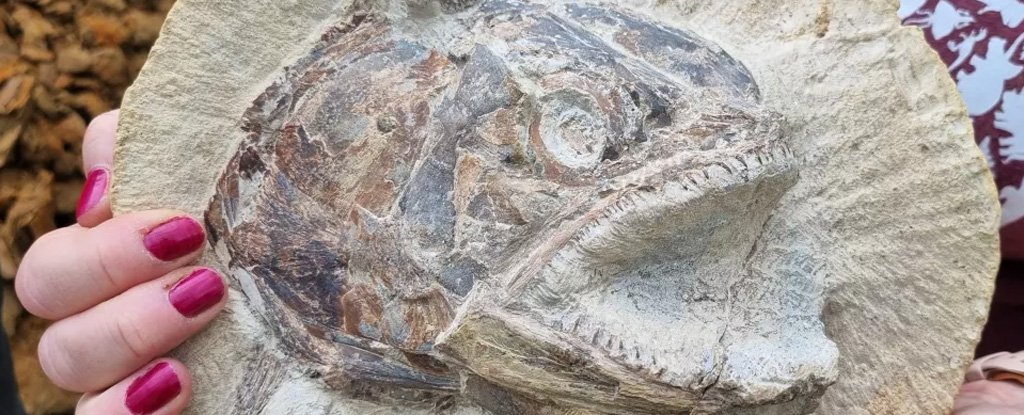Products You May Like
A farm in England was the unlikely source of a Jurassic jackpot: A treasure trove of 183 million-year-old fossils.
On the outskirts of Gloucestershire in the Cotswolds, beneath soil that is currently trampled under the hooves of grazing cattle, researchers recently uncovered the fossilized remains of fish, giant marine reptiles called ichthyosaurs, squids, insects, and other ancient animals dating to the early part of the Jurassic period (201.3 million to 145 million years ago).
Of the more than 180 fossils logged during the dig, one of the standout specimens was a three-dimensionally preserved fish head that belonged to Pachycormus, an extinct genus of ray-finned fishes. The fossil, which researchers found embedded in a hardened limestone nodule poking out of the clay, was exceptionally well preserved and contained soft tissues, including scales and an eye.
The 3D nature of the pose of the specimen’s head and body was such that the researchers couldn’t compare it to any other previous find.
“The closest analog we could think of was Big Mouth Billy Bass,” said Neville Hollingworth, a field geologist with the University of Birmingham who discovered the site with his wife, Sally, a fossil preparator and the dig’s coordinator.
“The eyeball and socket were well preserved. Usually, with fossils, they’re lying flat. But in this case, it was preserved in more than one dimension, and it looks like the fish is leaping out of the rock,” Hollingworth told Live Science.
“I’ve never seen anything like it before,” Sally Hollingworth added. “You could see the scales, skin, spine – even its eyeball is still there.
The sight astounded the Hollingworths so much that they contacted ThinkSee3D, a company that creates digital 3D models of fossils, to create aninteractive 3D image of the fish to help bring it to life and to allow researchers to study it more closely.
Related: Enormous graveyard of alien-like sea creatures discovered at ‘Jurassic Pompeii’ in central UK
Most of the fossils the Hollingworths and a team of scientists and specialists unearthed were located behind the farm’s cowshed. (The farm is home to a herd of English longhorn – a British breed of beef cattle with long, curved horns – many of which kept a close eye on the excavation.)
“It was a bit unnerving digging when you’re being watched by a herd of longhorn,” Sally Hollingworth told Live Science.
At one time, this region of the United Kingdom was completely submerged by a shallow, tropical sea, and the sediments there likely helped preserve the fossils; Neville Hollingworth described the Jurassic beds as slightly horizontal, with layers of soft clays under a shell of harder limestone beds.
“When the fish died, they sank to the bottom of the seabed,” said fossil marine reptile specialist Dean Lomax, a visiting scientist at the University of Manchester in the UK and a member of the excavation group.
“As with other fossils, the minerals from the surrounding seabed continually replaced the original structure of the bones and teeth. In this case, the site shows that there was very little to no scavenging, so they must’ve been rapidly buried by the sediment. As soon as they hit the seabed, they were covered over and protected immediately.”
During the four-day dig earlier this month, the eight-person team used a digger to excavate 262 feet (80 meters) across the farm’s grassy banks, “pulling back layers to reveal a small slice of geological time,” Neville Hollingworth said.
A number of diverse specimens dated to the Toarcian age (a stage of the Jurassic that occurred between 183 million and 174 million years ago) and included belemnites (extinct squid-like cephalopods), ammonites (extinct shelled cephalopods), bivalves and snails, in addition to fish and other marine animals.
“It’s important that we can compare these fossils with other Toarcian age fossil sites, not only in the UK but also across Europe and potentially sites in America,” Lomax said. He pointed to Strawberry Bank Lagerstätte, an early Jurassic site in southern England, as one such example.
The group plans to continue studying the specimens and is working toward publishing the findings. Meanwhile, a selection of the fossils will be placed on display at the Museum in the Park in Stroud.
Related content:
Jurassic squid got murdered mid-meal, leaving this epic fossil behind
Great white-shark-sized ancient fish discovered by accident from fossilized lung
10 coolest non-dinosaur fossils unearthed in 2021
This article was originally published by Live Science. Read the original article here.
